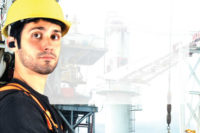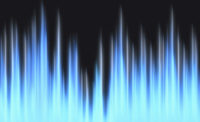Calculating NRR
Input data to calculate the NRR requires that hearing protection is tested via a method designed to assess the attenuation in the presence of continuous noise, using subjective response of a group of subjects with relatively normal hearing.
Sounds of different frequencies are presented, and the subject and test professional determine the hearing thresholds for each frequency with and without the protection in place. Because the maximum attenuation possible by tightly sealing a person’s ears is only about 50 to 60 decibels (the difference between a really quiet room and a conversation in a quiet room), the performance of the protector is measured in the linear acoustic regime.
That is, sound is attenuated by the protector and the attenuation doesn’t change appreciably for quiet, moderate or even loud sounds. For most of the noises that one might experience in the workplace or working with tools around the home or at activities like sporting events and concerts, the protectors will provide the same amount of attenuation. However, when one experiences exposures to extremely loud sounds like gunshots, fireworks and even some pneumatic tools (e.g. nail guns or powder-actuated tools), the attenuation provided by the hearing protector is no longer constant.
Testing limitations
Technically speaking, the NRR test method does not use sound that is similar to what is experienced during loud, impulsive noise events. The test for data to calculate NRR uses pulsed, 1/3 octave band-limited noises for test signals.2 Without hearing protection in place, the test signals are very quiet. With hearing protection in place, the test signals can be the same level and up to around 50 or 60 dB higher than the levels present without hearing protection in place.
However, even with the potential of 50 to 60 dB increased level, these levels do not come close to what happens when peak noise levels reach 115 dB and higher.
The attenuation of a typical earplug, ear muff or canal cap will not be the same for low-level noise as for high-level impulse interaction with the protector. Response will vary from nearly linear to highly non-linear response depending on the type of protector.3 Thus, the attenuation reported as the NRR and quantified with the method currently required by the EPA will not describe how well the protector performs to attenuate high-level impulsive sounds.
Proposed EPA IMPULSE rating
In 2009, the EPA proposed to change the way hearing protection is measured and reported.4 For hearing protectors designed to provide little attenuation at low levels and higher attenuation at high levels, the EPA developed an IMPULSE rating to describe the change in the peak impulse level over a range of 130 to 170 decibels.
The proposed ruling has not yet gone into effect, so there is still no requirement to label hearing protectors with an IMPULSE rating.
Since attenuation tends to increase as the impulse level increases, the constant value derived from the NRR measurement method will likely understate the amount of protection one may receive when wearing the protection properly.
New ANSI test method
The new ANSI S12.42 standard was approved and published in 2010 and has been used in several studies conducted by the National Institute for Occupational Safety and Health to provide support for the EPA’s proposed revision of the hearing protector labeling regulation.
To quantify the attenuation of this non-linear behavior, ANSI S12.42-2010 uses three levels of impulsive noises, with peak values at nominally 132, 150 and 168 dB SPL. Three levels are used instead of a single level, because the attenuation properties are non-linear, meaning that attenuation will be different, dependent on the level of the peak noise exposure. The amount of attenuation present for these different exposure levels is referred to as the Impulsive Peak Insertion Loss, abbreviated as IPIL. Insertion Loss is the terminology given to a certain type of attenuation that is characterized by measuring noise levels with and without some type of barrier in place with the difference of the noise levels with and without the barrier forming the basis for the Insertion Loss metric. IPIL5 is very similar to the EPA’s proposed IMPULSE rating.6
Use and understanding of IPIL and NRR
Several different methods to use the NRR to estimate the protection provided exist, and all utilize some method of ‘de-rating’ the NRR and the resultant protected noise exposure. No known derating method exists for the IPIL. Specifics for recommended NRR derating can be found on both OSHA and NIOSH resources.7,8
Example of use of a protector with NRR of 26, and IPIL of 37.3/44/42.
Peak impulse SPL of the noise: 150 dB
Estimated protected exposure with no derating using NRR: 150 – 26 = 124 dB
Estimated protected exposure using IPIL: 150-44 = 106 dB
Regardless of whether EPA finalizes its proposed regulation requiring an IMPULSE NRR, the hearing protector consumer should understand the distinctions between IPIL and NRR and how IPIL may be applied to estimate one’s exposure. It behooves the user of hearing protection to understand how to interpret use of IPIL as it pertains to estimating the hearing protection received when selecting and using hearing protection products for protecting high-level impulsive sounds.
There is really no known relationship between the NRR results, generated at linear acoustics levels, and the IPIL results generated at gunshot-like, non-linear acoustics levels. This makes the NRR on the product label somewhat irrelevant to understanding the attenuation potential for these types of sounds. No matter if one pays attention to NRR or IPIL, the hearing protection device user should exercise great care to fit the hearing protector according to the manufacturer’s instructions.
Bottom line
NIOSH has recommended that hunters and shooters wear dual protection, earmuffs and plugs, when engaging in target practice and recreational shooting. The levels at the eardrum when using a single protector are close to the recommended maximum exposure limit of 140 dB peak sound pressure level. When hunting in the field, electronic protectors will provide adequate protection against a limited number of impulses. Electronic protectors will affect one’s ability to localize sound compared to wearing no hearing protection whatsoever, but they can also enhance the ability to hear faint sounds outdoors that may compensate for the change in localization capability.
Pay attention to the protection performance as expressed by both the NRR and the IPIL. With non-electronic devices, a low NRR means that one will be able to hear faint sounds, while a high-level IPIL indicates the protection from the impulse noise exposures. Electronic devices with higher NRR allow the user to hear low-level sounds through amplification, while limiting amplifying high-impact sounds.
References:
1 US 40 CFR 211, Subpart B
2 ANSI S3.19-1974, section 3.1.1.2
3 International Journal of Occupational Safety and Ergonomics (JOSE) 2009, Vol. 15, No. 2, 227–240, section 4
4 Federal Register vol. 74, No. 149, August 5, 2009, Proposed Rules pages 39149-39196
5 ANSI S12.42-2010 section 11.3
6 Federal Register vol. 74, No. 149, August 5, 2009, pages 39193-39194, section 211.207-4
7 OSHA Methods for Estimating HPD Attenuation, Appendix https://www.osha.gov/dts/osta/otm/noise/hcp/attenuation_estimation.html
8 NIOSH Method for Calculating and Using the Noise Reduction Rating –NRR http://www2.cdc.gov/hp-devices/pdfs/calculation.pdf



